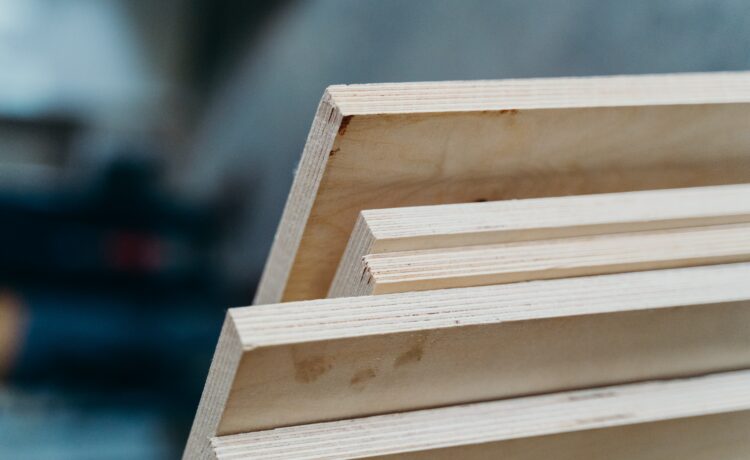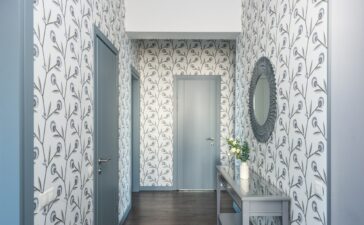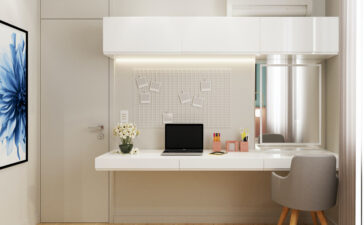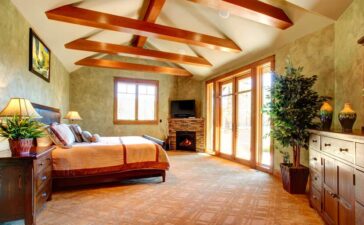There are so many woodwork projects out there, and many of them can be done by yourself. You can easily buy the wood and pieces of equipment to finish your project, along with a wide range of instructional videos on YouTube. If you are doing this for the first time, it can get overwhelming, but if you do the research ahead of time, you will be fine, and your woodwork project will turn out perfectly.
One type of wood being used is plywood. Plywood is a thin wooden board that is made up of two or more layers glued and pressed together; the grain directions are alternating. Since plywood can withstand a lot of stress, it is used for crates, boxes, bins, furniture, and internal structures.
This article shows you the different plywood types, grades, and prices available in the market so that you can pick the one you need for your projects.
Different Types of Plywood
You might only realize that there are different types of plywood if you have a need for plywood. Plywood is versatile and affordable, so that’s why it is used for various woodwork projects. If you know what type of plywood you need, then you will save money and time, and you can get started on your project as soon as possible.
1. Softwood Plywood

Softwood plywood is made from pine, spruce, redwood, cedar, fir, Douglas fir, and other softwoods. It is still used for heavy woodwork projects. This type of plywood is used for roof sheathing, sub-flooring, frame sheathing, and other industrial and construction purposes. This plywood is made from strong materials and is sturdy, but it is not suited for exterior projects.
2. Hardwood Plywood

This type of plywood is made from oak, maple, beech, birch, walnut, mahogany, and other hardwood. Hardwood is made up of anything from 3 to 7 layers or even more which gives it a strong and sturdy finish. These layers are glued together at the right angle and depth since hardwood is used for heavy plywood projects. This type of plywood is used for projects needing sturdy frames like sporting equipment, wood casings, furniture, musical instruments, packing cases, and others.
3. Aircraft Plywood

Aircraft plywood is considered one of the most durable and high-grade plywood types in the market. It is made from hardwoods like mahogany, spruce, and birch so that the boards are resistant to heat and moisture. Thin wooden veneers make the boards light, flexible, and more workable. Aircraft plywood is used for aircraft building, heavy-load furniture, boats, rafters, and buildings that need industrial-strength plywood.
4. Exterior Plywood

Exterior plywood is used for exterior projects, just like the name suggests. Using the right glue or adhesive, this type of plywood is resistant to weather and water. Good exterior plywood makes for strong and sturdy frames withstanding rain, snow, wind, and other weather conditions for many decades. Many veneers are glued together, making this multiply. This is why you need to keep weather conditions in mind when buying exterior plywood. Oak exterior plywood is preferred since it is resistant to mold and mildew in damp conditions.
5. Tropical Plywood

Tropical plywood is originally from Asia and is made from a mix of tropical timber from Indonesia, the Philippines, Malaysia, and other countries. It has superior strength, quality, density, and layer uniformity. Countries like the U.S., Japan, the U.K., Dubai, Taiwan, Korea, and others use tropical plywood.
6. Lumber Core Plywood

Lumber core plywood is designed as a 3-ply. This plywood is made with a thick wood core with two thin wood veneers on each side. The outer layer of the plywood is created from birch, oak, maple, and other hardwoods. The inside layers are created from various types of softwood; these stripes are glued together, creating a sturdy wooden slab. Projects that need to be screwed and nailed require lumber-core plywood because of the soft interior. If you are buying lumber-core plywood, you must be careful. Otherwise, the nails and screws will not hold.
7. Marine Plywood

Marine plywood works well in humid and wet conditions as it is made from core veneers; it resists fungal attacks and delaminates much better. This is why you use marine plywood in places where it will be in close contact with moisture for long periods of time. You will know it is marine plywood due to the lack of knotholes. The wood veneers are made from tropical hardwoods; high-quality woods like Douglas fir or western larch are used. This gives a small core gap that gives few chances of water trapping in the plywood. That’s why you get a solid and stable glue bond in marine plywood.
8. Overlaid Plywood

Overlaid plywood comes in medium density (MDO) or high density (HDO) due to the fact that the wood veneers bond under conditions of high heat and pressure. HDO plywood is more expensive than MDO due to more resin being used. This type of plywood is the same as others, for example, ash, oak, birch, maple, mahogany, teak, maple, rosewood, red oak, or other hardwoods. The top is finished with a thin veneer made of ornamental wood. The overlaid face makes the plywood more durable and resistant to water, scratches, and other forms of damage.
9. Structural Plywood

Structural plywood is also called sheathing plywood, as it is known for durability and strength in framing and building. This kind of plywood is used inside and outside for framing, beams, flooring, and bracing panels. Typically, structural plywood is given C or D grade hence why they are inexpensive.
10. Moisture Resistant Plywood

Moisture-resistant (MR) plywood is also called commercial ply, and it is used considerably inside from furniture pieces to cabinets. Since it is resistant to moisture in damp and humid conditions, moisture-resistant plywood is the perfect pick in tropical areas. But it is not waterproof, unfortunately.
11. Boiling Water Resistant and Boiling Water Proof Plywood

Boiling water resistant (BWR) and boiling waterproof (BWP) plywood is used indoors and outdoors. As the name suggests, it is water resistant and perfect for all weather conditions. Typically found in kitchens and bathrooms due to the large exposure to water. Since it is waterproof, the type of plywood is ideal for exterior wall cladding and staircases.
12. Sanded Plywood

Sanded plywood’s top, bottom, and face plies are sanded so that they look uniform and smooth. That’s why it has a high finish quality and the ideal strength-to-weight proportion. Sanded plywood is used for paneling, cabinets, and shelves. It is strong, so that’s why it can be utilized for structural applications.
13. Flexible Plywood

Flexible plywood is used for curves and bends in construction frames and furniture pieces. It is made from cross-grained central ply and thick cross-grained plys on both sides; overlaid wooden veneers are on the surface level for a shiny and decorative surface.
14. Construction Plywood

Construction plywood refers to many different plywood types. It is used for structural and non-structural panels; particleboards, foam boards, MDF core ply, and others are covered. The non-structural boards may have a soft look, but all construction plywoods are extremely strong and sturdy.
15. Veneer Core Plywood

Veneer core plywood is known for having odd-numbered veneers in the core. It usually has a center veneer, and on its sides, cross-grained veneers are alternately glued. This type of plywood is all-encompassing since it can hold large weights, the holding of nails and screws is perfect due to its softness, and it is flexible enough to be bent in curves.
16. MDF Core

MDF core is made from individual wood fibers, and it does not give off wood chips or sawdust. It is much flatter than most softwood plywood boards, so it is the ideal pick for furniture bases. You can also work with paints, resin, or vinyl coating with MDF core. This plywood type is much heavier than most other types, but compared to particleboard, the MDF core is much more durable and sturdier.
17. Exterior Sheathing Plywood

Exterior sheathing plywood is re-engineered plywood which is two times stronger than normal plywood. Usually, it is used for exterior sheathing, roofing, and roof decking. It has many types like CDX, OSB, the most common type, and others. Waterproof adhesives are used on this plywood, and it is usually semi-exposed to fend off wearing. Exterior sheathing plywood also has compressed wood flakes scattered in many angles, just like particleboard.
18. Subfloor Plywood

Subfloor plywood is an important part as this is when the floor finish is attached. Subfloor plywood is an affordable pick as compared to concrete subfloor. In terms of subfloor plywood, OSB plywood and CDX plywood are the most common. Both types are much sturdier than regular plywood, and nailing can be done since they are soft enough.
19. Sundeala Board

Sundeala board is the most sustainable of all types of plywood. It is made from recycled newspapers and then reinforced to make the plywood more sturdy. This makes it eco-friendly and long-lasting. The usual size is 4×8, and there are many different color variants. This plywood is used in information boards, cork boards, and model railways.
Different Grades of Plywood

Plywood types have four grades: A, B, C, and D. These refer to the quality and appearance of the plywood; the plywood will be finer, more visually appealing, and more expensive with a higher grade like an A, while a D will be the opposite of that. You do not need to buy A-grade plywood for every job. For example, C or D-grade plywood would be perfect for subflooring, while exterior projects will need A-grade plywood.
You may also find plywood ratings consisting of two letters. For example, a BC grade refers to mixed-grade plywood; one side has a B grade, and the other side has a C grade.
An A grade is given to plywood with a smooth and sanded surface without knots. Any wood defects are repaired with synthetic filler so that you can paint the veneer. For furniture or cabinet doors, A-grade plywood is perfect. The B grade is assigned to plywood with a smooth and sanded surface, but there might be some repaired defects up to 1 inch across.
The C grade is for plywood that is unsanded and has many minor defects that need repairing with knots up to 1 ½ inches across. There will be some discoloration and sanding defects also. This graded plywood is used when appearances are not the priority, like subfloors or garages. The D grade is unsanded, has defects that need repairing, and has knot holes up to 2 ½ inches across. You will also get some discoloration and sanding defects.
Prices of Plywood

When buying different plywood types, the grades will affect the price. Here is an estimated price range for cabinet-grade and construction-grade plywood.
Regarding construction grade, there is OSB and CDX plywood. A 4×8 CDX plywood sheet at 15/32” thickness will cost you around $28 – $30, and you can purchase a 4×8 plywood at 23/32” thickness for around $35 – $37. For OSB plywood, you will have to pay around $5 – $15, depending on the plywood’s thickness.
If you need cabinet-grade plywood, you can find sanded pine ply for around $13 – $21, and hardwood ply is for around $18 – $45. Also, the price range for oak hardwood ply is usually $25 – $45, and you can buy birch plywood for around $41 – $45. Of course, different stores will have different prices based on supply and demand; the prices also change due to market conditions.
Final Thoughts
Woodworking is an important occupation, and now it has become a hobby for many. There are so many projects for you to try your hand at, and there are many guides to help you along the way. What wood to buy, how to cut it, how to set it, what tools you need, and so many other questions are answered so that your project goes off without a hitch. That’s why it is so important to do your research right and thoroughly.
This article helps you by providing a list of plywood types, grades, and prices. This way, you are not overwhelmed, and your woodwork project can get started as soon as possible.
Write down in the comments below which type of plywood you used in your projects, why did you pick that particular type of plywood, how much the plywood cost, what was your woodwork project, and other important details you think other people should know about when planning woodwork projects.









